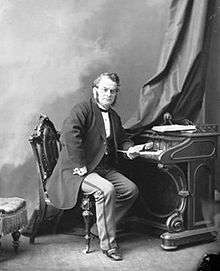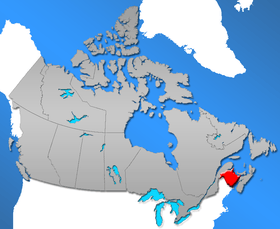History of New Brunswick
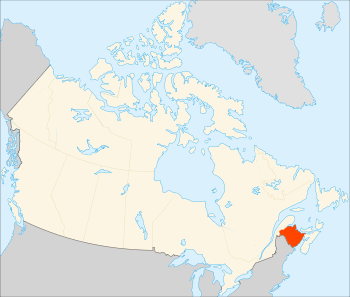

New Brunswick (French: Nouveau-Brunswick), is one of the three Maritime provinces in Canada, and the only officially bilingual province (English-French) in the country. The history of New Brunswick can be viewed according to four periods: pre-European contact, French colonization, British colonization and finally, New Brunswick since Confederation.
Pre-European
The aboriginal nations of New Brunswick include the Mi'kmaq, Maliseet/Wolastoqiyuk and Passamaquoddy. The Mi'kmaq territories are mostly in the east of the province. The Maliseets are located in the northwest and the Passamaquoddy tribe is situated in the southwest, around Passamaquoddy Bay. Amerindians have occupied New Brunswick since about 6000-8000 BCE.
Maliseet

The Maliseet (also known as Wolastoqiyik and Malecite and in French as Malécites or Étchemins (the latter collectively referring to the Maliseet and Passamaquoddy)) are a First Nations people who inhabit the Saint John River valley and its tributaries, roughly overlapping the International Boundary between New Brunswick and Quebec in Canada, and Maine in the United States.
Wolastoqiyik is the name for the people and their language; Maliseet is the name by which the Mi'kmaq described the Wolastoqiyik to early Europeans. "Maken talkers"; the Wolastoqiyik and Mi'kmaq languages are fairly closely related, but the name reflected what the Mi'kmaq perceived to be a sufficiently different dialect to be a "broken" version of their own language. The Wolastoqiyik so named themselves because their territory and existence centered on a river they called the Wolastoq, which simply meant "good river" or "beautiful river"; "woli" = good or beautiful, shortened to "wol-" when used as modifier; "astoq" = river; "-iyik" = people of, equivalent e.g. of "-ians" or "-ites". Wolastoqiyik therefore means simply People of the Beautiful River, in their own language. The Wolastoq River is the Saint John River.
Before contact with the Europeans, the traditional culture of both the Maliseet and Passamaquoddy generally involved travelling downstream on their rivers in the spring, and back upstream in the autumn. When they had finished travelling downstream in the spring, they congregated in larger groups near the ocean, and planted crops, largely of corn (maize), beans, squash. In the autumn, after the harvest, they travelled back upstream, taking provisions, and spreading out in smaller groups into the larger countryside to hunt game during the winter.
Passamaquoddy
The Passamaquoddy (Peskotomuhkati or Pestomuhkati in the Passamaquoddy language) are a First Nations people who live in northeastern North America, primarily in Maine and New Brunswick.
The Passamaquoddy lacked a written history before the arrival of Europeans but do have an extensive oral tradition. They maintained a semi-nomadic existence in the well-watered woods and mountains of the coastal regions along the Bay of Fundy and Gulf of Maine and along the St. Croix River and its tributaries. They dispersed and hunted inland in the winter; in the summer, they gathered more closely together on the coast and islands and farmed corn, beans, and squash, and harvested seafood, including porpoise.
The name Passamaquoddy is an anglicization of the Passama word peskotomuhkati, the prenoun form (prenouns being a linguistic feature of Algonquian languages) of Peskotomuhkat, the name they applied to themselves. Peskotomuhkat literally means "pollock-spearer", reflecting the importance of this fish.[1] Their method of fishing was spear-fishing rather than angling.
The Passamaquoddy were moved off land repeatedly by European settlers since the 16th century and were eventually limited in the United States to the current Indian Township Reservation in eastern Washington County, Maine. The Passamaquoddy also live in Charlotte County, New Brunswick, and maintain active land claims but have no legal status in Canada as a First Nation. Some Passamaquoddy continue to seek the return of territory now located in St. Andrews, New Brunswick which they claim as Qonasqamkuk, a Passamaquoddy ancestral capital and burial ground.
Mi'kmaq
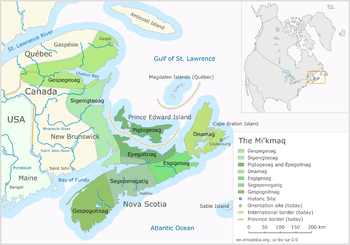
The Mi'kmaq (previously spelled Micmac in English texts) are a First Nations people, indigenous to the Maritime Provinces, the Gaspé Peninsula Quebec and northeastern New England. Míkmaw is the singular form of Míkmaq.
In 1616 Father Biard believed the Mi'kmaq population to be in excess of 3,000. However, he remarked that, because of European diseases, including smallpox, there had been large population losses in the previous century.
The Mi'kmaq were originally allies with other nearby Algonquian nations including the Abenaki, forming the seven nation Wabanaki Confederacy, pronounced [wɑbɑnɑːɣɔdi]; this was later expanded to eight with the ceremonial addition of Great Britain at the time of the 1749 treaty. At the time of contact with the French (late 16th century) they were expanding from their Maritime base westward along the Gaspé Peninsula /St. Lawrence River at the expense of Iroquioian Mohawk tribes, hence the Mi'kmaq name for this peninsula, Gespedeg ("last-acquired").
They were amenable to limited French settlement in their midst, but as France lost control of Acadia in the early 18th century, they soon found themselves overwhelmed by British (English, Irish, Scottish, Welsh) who seized much of the land without payment and deported the French. Later on the Mi'kmaq also settled Newfoundland as the unrelated Beothuk tribe became extinct.
Viking Exploration
It is generally accepted by Norse scholars that Vikings explored the coasts of Atlantic Canada, including Old Brunswick, during their stay in Vinland where their base was possibly at L'Anse aux Meadows, Newfoundland, around the year 1000. Wild walnut (butternut) shells found at l'Anse aux Meadows suggest that the Vikings did indeed explore further along the Atlantic Coast. Butternut trees do not now grow in Newfoundland, but recent studies suggest that due to environmental changes butternuts may have grown in Newfoundland around the year 1000-1001 AD. [2]
French Colonial era
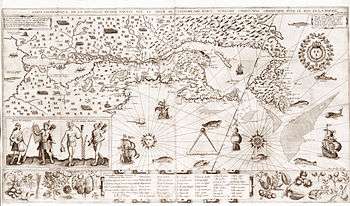
The first recorded European exploration of present-day New Brunswick was by French explorer Jacques Cartier in 1534, who discovered and named the Baie des Chaleurs between northern New Brunswick and the Gaspé peninsula of Quebec.
The next French contact was in 1604, when a party led by Pierre Dugua (Sieur de Monts) and Samuel de Champlain sailed into Passamaquoddy Bay and set up a camp for the winter on St. Croix Island at the mouth of the St. Croix River. 36 out of the 87 members of the party died of scurvy by winter's end and the colony was relocated across the Bay of Fundy the following year to Port-Royal in present-day Nova Scotia. Gradually, other French settlements were destroyed and seigneuries were founded. These were located along the Saint John River (including Fort La Tour and Fort Anne), the upper Bay of Fundy (including a number of villages in the Memramcook and Petitcodiac river valleys and the Beaubassin region at the head of the bay), and St. Pierre, (founded by Nicolas Denys) at the site of present-day Bathurst on the Baie des Chaleurs.
The whole region of New Brunswick (as well as Nova Scotia, Prince Edward Island and parts of Maine) were at that time proclaimed to be part of the royal French colony of Acadia. The French maintained good relations with the First Nations during their tenure and this was principally because the French colonists kept to their small coastal farming communities, leaving the interior of the territory to the aboriginals. This good relationship was bolstered by a healthy fur trading economy.
A competing British (English and Scottish) claim to the region was made in 1621, when Sir William Alexander was granted, by James VI & I, all of present-day Nova Scotia, New Brunswick and part of Maine. The entire tract was to be called '"Nova Scotia", Latin for "New Scotland". Naturally, the French did not take kindly to the British claims. France however gradually lost control of Acadia in a series of wars during the 18th century.
Civil War

Acadia was plunged into what some historians have described as a civil war in Acadia (1640–1645). The war was between Port Royal, where Governor of Acadia Charles de Menou d'Aulnay de Charnisay was stationed, and present-day Saint John, New Brunswick, where Charles de Saint-Étienne de la Tour was stationed.[3]
In the war, there were four major battles. la Tour attacked d'Aulnay at Port Royal in 1640.[4] In response to the attack, D'Aulnay sailed out of Port Royal to establish a five-month blockade of La Tour's fort at Saint John, which La Tour eventually defeated (1643). La Tour attacked d'Aulnay again at Port Royal in 1643. d'Aulnay and Port Royal ultimately won the war against La Tour with the 1645 siege of Saint John.[5] After d'Aulnay died (1650), La Tour re-established himself in Acadia.
King William's War
The Maliseet from their headquarters at Meductic on the Saint John River, participated in numerous raids and battles against New England during King William's War.
Queen Anne's War

One of its provisions of the Treaty of Utrecht of 1713, which formally ended the Queen Anne's War, was the surrender of peninsular Nova Scotia to the British crown. All of what later became New Brunswick, as well as "Île St-Jean" (Prince Edward Island) and "Île Royale" (Cape Breton Island) would remain under French control.
The bulk of the Acadian population now found itself residing in the new British colony of Nova Scotia. The remainder of Acadia (including the New Brunswick region) was only lightly populated, with major Acadian settlements in New Brunswick only found at Beaubassin (Tantramar) and the nearby region of Shepody, Memramcook, and Petitcodiac, which they called Trois-Rivière,[6] as well as in the Saint John River valley at Fort la Tour (Saint John) and Fort Anne (Fredericton).
British Colonial era
The colony of Acadia passed into British hands with the Treaty of Utrecht (1713), but the new owners were slow to occupy their new possession. Until the definitive peace in the Americas occasioned by the Treaty of Paris (1763), the region was subject to low-grade contention.
Father Rale's War
The Maliseet from their headquarters at Meductic on the Saint John River, participated in numerous raids and battles against New England during Father Rale's War.
Father Le Loutre's War
During Father Le Loutre's War, in 1750, in order to protect their territorial interests in what remained of Acadia, France built three forts (Fort Beauséjour, Fort Menagoueche and Fort Gaspareaux) along the frontier with Nova Scotia. (A major French fortification (Fortress of Louisbourg) was also built on Île Royale (now Cape Breton Island) after Queen Anne's War, but the function of this fort was mostly to defend the approaches to the colony of Canada, not Acadia.) During this time there were numerous raids and battles at Chignecto.
French and First Nations War

The British Conquest of Acadia happened in 1710. Over the next forty-five years the Acadians refused to sign an unconditional oath of allegiance to Britain. During this time period Acadians participated in various militia operations against the British and maintained vital supply lines to the French Fortress of Louisbourg and Fort Beausejour.[7] During the French and Indian War, the British sought both to neutralize any military threat Acadians posed and to interrupt the vital supply lines Acadians provided to Louisbourg by deporting Acadians from Acadia.[8]
After the Siege of Louisbourg (1758), the second wave of the Expulsion of the Acadians began. Moncton was sent on the St. John River Campaign and the Petitcodiac River Campaign. Commander Rollo accomplished the Ile Saint-Jean Campaign. And Wolfe was sent on the Gulf of St. Lawrence Campaign. In the Gulf of St. Lawrence Campaign (1758), the British wanted to clear the Acadians from the villages along the Gulf of St. Lawrence to prevent any interference with the Siege of Quebec (1759).[9] Fort Anne fell during the St. John River Campaign and following this, all of present-day New Brunswick came under British control. France ultimately lost control of all of its North American territories by 1760.

Treaty of Paris
In the Treaty of Paris (1763), which put a close to the wider hostilities between Britain, France and Spain, was recognised the eviction of France from North America.
After the Seven Years' War, which is the name for the North American part of these hostilities, most of what is now New Brunswick (and parts of Maine) was incorporated into the colony of Nova Scotia as Sunbury County (county seat - Campobello). New Brunswick's relative location away from the Atlantic coastline hindered new settlement during the immediate post war period. There were a few notable exceptions, such as the founding of "The Bend" (present-day Moncton) in 1766 by Pennsylvania Dutch settlers sponsored by Benjamin Franklin's Philadelphia Land Company.
Other American settlements developed, principally in former Acadian lands in the southeast region, especially around Sackville. An American settlement also developed at Parrtown (Fort la Tour) at the mouth of the Saint John River. English settlers from Yorkshire also arrived in the Tantramar region near Sackville prior to the Revolutionary War.
American Revolution
The American Revolutionary War had a direct effect on the New Brunswick region: the Maugerville Rebellion (1776), the Battle of Fort Cumberland, Siege of Saint John (1777) and the Battle at Miramichi (1779). Significant population growth would not occur until after the American Revolution, when Britain convinced refugee Loyalists from New England to settle in the area by giving them free land. It should be noted that some earlier American settlers in New Brunswick actually favoured the colonial revolutionary cause.[10] In particular, Jonathan Eddy and his militia harassed and laid siege to the British garrison at Fort Cumberland (the renamed Fort Beausejour) during the early parts of the American Revolution. It was only after the arrival of a relief force from Halifax that the siege was lifted.
With the arrival of the Loyalist refugees in Parrtown (Saint John) in 1783,[11] the need to politically organize the territory became acute. The newly arrived Loyalists felt no allegiance to Halifax and wanted to separate from Nova Scotia to isolate themselves from what they felt to be democratic and republican influences existing in that city. They felt that the government of Nova Scotia represented a Yankee population which had been sympathetic to the American Revolutionary movement, and which disparaged the intensely anti-American, anti-republican attitudes of the Loyalists. "They [the loyalists]," Colonel Thomas Dundas wrote from Saint John, New Brunswick, December 28, 1786, "have experienced every possible injury from the old inhabitants of Nova Scotia, who are even more disaffected towards the British Government than any of the new States ever were. This makes me much doubt their remaining long dependent."[12] These views undoubtedly were exaggerated but there was no love lost between the Loyalists and the Halifax establishment and the feelings of the newly arrived Loyalists helped to sow the seeds for partition of the colony.
The British administrators of the time, for their part, felt that the colonial capital (Halifax) was too distant from the developing territories to the west of the Isthmus of Chignecto to allow for proper governance and that the colony of Nova Scotia therefore should be split. As a result, the colony of New Brunswick was officially created with Sir Thomas Carleton the first governor on August 16, 1784.
New Brunswick was named in honour of the British monarch, King George III, who was descended from the House of Brunswick (Haus Braunschweig in German, derived from the city of Braunschweig, now Lower Saxony). Fredericton, the capital city, was likewise named for George III's second son, Prince Frederick, Duke of York and Albany.
The choice of Fredericton (the former Fort Anne) as the colonial capital shocked and dismayed the residents of the larger Parrtown (Saint John). The reason given was because Fredericton's inland location meant it was less prone to enemy (i.e. American) attack. Saint John did, however, become Canada's first incorporated city and for a long time was one of the dominant communities in British North America. Saint John in 1787-91 was home to the American traitor Benedict Arnold. He was an aggressive businessman who sued a great deal and had a negative reputation by the time he quit and went to London.[13]
Acadians return
Some deported Acadians from Nova Scotia found their way back to "Acadie" during the late 18th and early 19th centuries. They settled mostly in coastal regions along the eastern and northern shores of the new colony of New Brunswick. There they lived in relative (and in many ways self-imposed) isolation as they tried to maintain their language and traditions.
War of 1812
The War of 1812 had little effect on New Brunswick proper. There was however some action on the waters of the Bay of Fundy and Gulf of Maine by privateers and small vessels of the British navy.[14] Forts such as the Carleton Martello Tower in Saint John and the St. Andrew's Blockhouse on Passamaquoddy Bay were constructed, but no action was seen. Locally, New Brunswickers were on good terms with their neighbours in Maine as well as the rest of New England, who generally did not support the war. There was even one incident during the war where the town of St. Stephen lent its supplies of gunpowder to neighbouring Calais, Maine, across the St. Croix River, for the local Fourth of July Independence Day celebrations.

U.S. border
The Maine-New Brunswick frontier had not been defined by the Treaty of Paris (1783) which had concluded the Revolutionary War. The border was contested, and frequently this fact was taken advantage of by people on both sides of the border to engage in a lively smuggling trade, especially on the waters of Passamaquoddy Bay. The illicit trade in Nova Scotia gypsum resulted in the so-called "Plaster War" of 1820.[15]
By the 1830s competing lumber interests and immigration meant that a solution was required. The situation actually deteriorated sufficiently enough by 1842 that the Governor of Maine called out his militia. This was followed by the arrival of British troops in the region shortly thereafter. The entire debacle, referred to as the Aroostook War, was bloodless and thankfully, cooler heads prevailed with the subsequent Webster-Ashburton Treaty settling the dispute. Some local residents in the Madawaska region did not care much one way or the other as to who would actually win control of the area. When one resident of Edmundston was asked by arbitrators which side he supported, he replied "the Republic of Madawaska". This name is still used today and describes the northwestern corner of the province.
Immigration
.jpg)
Immigration in the early part of the 19th century was mostly from the west country of England and from Scotland, but also from Waterford, Ireland having often come through or having lived in Newfoundland prior.
A large influx of Catholic settlers arrived in New Brunswick in 1845 from Ireland as a result of the Potato Famine. They headed to the cities of Saint John or Chatham, which to this day calls itself the "Irish Capital of Canada". Established Protestants resented the newly arrived Catholics. Until the 1840s, Saint John, the major city of New Brunswick, was a largely homogenous, Protestant community. Combined with a decade of economic distress in New Brunswick, the immigration of poor unskilled labourers triggered a nativist response. The Orange Order, until then a small and obscure fraternal order, became the vanguard of nativism in the colony and stimulated Orange-Catholic tension. The conflict culminated in the riot of 12 July 1849, in which at least 12 people died. The violence subsided as Irish immigration declined.[16]
Economy
Throughout the 19th century, shipbuilding, beginning in the Bay of Fundy with shipbuilders like James Moran in St. Martins and soon spreading to the Miramichi, became the dominant industry in New Brunswick. The ship Marco Polo, arguably the fastest clipper ship of her time was launched from Saint John in 1851. Noted shipbuilders like Joseph Salter laid the foundations of towns such as Moncton. Resource-based industries such as logging and farming were also important to the New Brunswick economy. From the 1850s through to the end of the century, several railways were built across the province, making it easier for these inland resources to make it to markets elsewhere.
New Brunswick since confederation
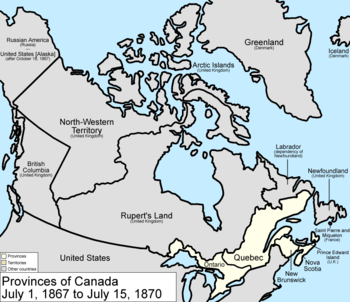
New Brunswick was one of the four original provinces of Canada that entered into Confederation in 1867. The Charlottetown Conference of 1864 had originally been intended only to discuss a Maritime Union of New Brunswick, Nova Scotia and Prince Edward Island, but concerns over the American Civil War as well as Fenian activity along the border led to an interest in expanding the geographic scope of the union. This interest arose from the Province of Canada (formerly Upper and Lower Canada, later Ontario and Quebec) and a request was made by the Canadians to the Maritimers to have the meeting's agenda altered.
Economic decline
Following Confederation, the naysayers were proven right and New Brunswick (as well as the rest of the Maritimes) suffered the effects of a significant economic downturn. New national policies and trade barriers that had been created as a result of Confederation disrupted the historic trading relationship between the Maritime Provinces and New England. The situation in New Brunswick was exascerbated by the Great Fire of 1877 in Saint John and by the decline of the wooden sailing shipbuilding industry.
The global recession sparked by the Panic of 1893 significantly affected the local export economy. Many skilled workers lost their jobs and were forced to move west to other parts of Canada or south to the United States, but as the 20th Century dawned, the province's economy began to expand again. Manufacturing gained strength with the construction of several textile mills across the province and, in the crucial forestry sector, the sawmills that had dotted inland sections of the province gave way to larger pulp and paper mills. Nevertheless, unemployment remained relatively high and the Great Depression provided another setback. Two influential families, the Irvings and the McCains, emerged from the depression to begin to modernize and vertically integrate the provincial economy.
Louis Robichaud
The Acadians, who had mostly fended for themselves on the northern and eastern shores since they were allowed to return after 1764, were traditionally isolated from the English speakers that dominated the rest of the province. Government services were often not available in French, and the infrastructure in predominantly francophone areas was noticeably less evolved than in the rest of the province. This changed with the election of premier Louis Robichaud in 1960. He embarked on the ambitious Equal Opportunity Plan in which education, rural road maintenance, and health care fell under the sole jurisdiction of a provincial government that insisted on equal coverage of all areas of the province. Teachers were awarded equal rates of pay regardless of enrollment.
County councils were abolished with the rural areas outside cities, towns and villages coming under direct provincial jurisdiction. The 1969 Official Languages Act made French an official language, on par with English. Linguistic tensions rose on both sides, with the militant Parti Acadien enjoying brief popularity in the 1970s and Anglophone groups pushing to repeal language reforms in the 1980s, led by the Confederation of Regions Party. By the 1990s however linguistic tensions had mostly evaporated.
See also
- Military history of the Mi’kmaq People
- Military history of the Maliseet people
- Military history of the Acadians
- History of the Acadians
- Aboriginal communities in New Brunswick
- List of New Brunswick premiers
- List of New Brunswick lieutenant-governors
- Aboriginal place names in New Brunswick
- List of historic places in New Brunswick
- List of National Historic Sites of Canada in New Brunswick
- History of Moncton
General:
Further reading
- Acheson, T. W. Saint John: The Making of a Colonial Urban Community (1985)
- Andrew; Sheila. "Gender and Nationalism: Acadians, Québécois, and Irish in New Brunswick Nineteenth-Century Colleges and Convent Schools, 1854-1888," Historical Studies, 2002
- Andrew, Sheila. The Development of Elites in Acadian New Brunswick, 1861-1881.(McGill-Queen's University Press 1996). 278pp.
- Aunger, Edward A. In Search of Political Stability: A Comparative Study of New Brunswick and Northern Ireland. (McGill-Queen's U. Press) 224p.
- Barkley, Murray. "The Loyalist Tradition in New Brunswick." Acadiensis. 4 (1975): 3-45.
- Benedict, William H. New Brunswick in history (1925)
- Bell, D. G. Early Loyalist Saint John: The Origins of New Brunswick Politics, 1783-1786 (Fredericton: New Ireland Press, 1983)
- Gair, Reavley. A Literary and Linguistic History of New Brunswick (1986)
- Godfrey, W. G. "Carleton, Thomas," Dictionary of Canadian Biography Online (2000) online edition
- MacNutt, W. S. New Brunswick: A History, 1784-1867 (1984)
- Mancke; Elizabeth The Fault Lines of Empire: Political Differentiation in Massachusetts and Nova Scotia, Ca. 1760-1830 (2004) excerpts
- Marquis; Greg. "Commemorating the Loyalists in the Loyalist City: Saint John, New Brunswick, 1883-1934," Urban History Review, Vol. 33, 2004
- Nerbas, Don. "Adapting to Decline: the Changing Business World of the Bourgeoisie in Saint John, NB, in the 1920s" Canadian Historical Review 2008 89(2): 151-187 37p.
- Richard, Chantal, et al. "Markers of Collective Identity in Loyalist and Acadian Speeches of the 1880s: A Comparative Analysis." Journal of New Brunswick Studies/Revue d’études sur le Nouveau-Brunswick 4 (2013). online
- See, Scott. Riots in New Brunswick: Orange Nativism and Social Violence in the 1840s (University of Toronto Press, 1993).
- Stewart; Ian. Roasting Chestnuts: The Mythology of Maritime Political Culture (1994) excerpts
- Whitcomb, Dr. Ed. A Short History of New Brunswick. Ottawa. From Sea To Sea Enterprises, 2010. ISBN 978-0-9865967-0-4. 69 pp.
- Whitelaw; William Menzies. The Maritimes and Canada before Confederation (1934) excerpts
- Woodward, Calvin A. The history of New Brunswick provincial election campaigns and platforms, 1866-1974: With primary source documents on microfiche (1976)
Older books
- Atkinson, Christopher William: A Historical and Statistical Account of New-Brunswick, B.N.A. (1844) 284 pages
- Fisher, Peter: History of New Brunswick (1825)
- Gesner, Abraham: New Brunswick: With Notes for Emigrants. Comprehending the Early History... (1847) 388 pages
- Hannay, James: The Life and Times of Sir Leonard Tilley: Being a Political History of New Brunswick (1897)
References
- ↑ "Passamaquoddy - Maliseet Dictionary". Lib.unb.ca. 2009-08-15. Retrieved 2010-09-22.
- ↑ Fanny D. Bergen. "Popular American Plant-Names." The Journal of American Folklore 17: 89-106.
- ↑ M. A. MacDonald, Fortune & La Tour: The civil war in Acadia, Toronto: Methuen. 1983
- ↑ Brenda Dunn, p. 19
- ↑ Brenda Dunn. A History of Port Royal, Annapolis Royal: 1605-1800. Nimbus Publishing, 2004. p. 20
- ↑ Paul Surette, Memramckouke, Petcoudiac et la Reconstruction de l'Acadie - 1763-1806 Mamramcook, 1981, p. 9
- ↑ John Grenier, Far Reaches of Empire: War in Nova Scotia 1710-1760. Oklahoma Press. 2008
- ↑ Stephen E. Patterson. "Indian-White Relations in Nova Scotia, 1749-61: A Study in Political Interaction." Buckner, P, Campbell, G. and Frank, D. (eds). The Acadiensis Reader Vol 1: Atlantic Canada Before Confederation. 1998. pp.105-106.; Also see Stephen Patterson, Colonial Wars and Aboriginal Peoples, p. 144.
- ↑ From Life of General the Honourable James Murray by R. H. Mahon, p. Page 70
- ↑ http://etc.lib.unb.ca/educationhistory/MacNcha3
- ↑ http://www.mocavo.com/History-of-New-Brunswick/102214/13 History of New Brunswick, Page 9
- ↑ S.D. Clark, Movements of Political Protest in Canada, 1640–1840, (1959), pp. 150-51
- ↑ Wilson, Barry (2001). Benedict Arnold: A Traitor in Our Midst. McGill-Queen's Press. p. 191ff. ISBN 978-0-7735-2150-6.
- ↑ Smith, Joshua (2011). Battle for the Bay: The Naval War of 1812. Fredericton, NB: Goose Lane Editions. pp. passim. ISBN 978-0-86492-644-9.
- ↑ Smith, Joshua (2007). Borderland Smuggling: Patriots, Loyalists, and Illicit Trade in the Northeast, 1780-1820. Gainesville, FL: UPF. pp. 95–108. ISBN 0-8130-2986-4.
- ↑ Scott W. See, "The Orange Order and Social Violence in Mid-Nineteenth Century Saint John," Acadiensis 1983 13(1): 68-92

